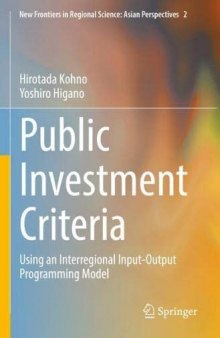 جزییات کتاب
جزییات کتاب
This volume presents the most robust and useful methodology for the measurement and derivation of public investment criteria. The methodological approach solves inherent defects of traditional methodology, namely, an ad hoc application of the benefit-cost analysis. Although this approach originated in the water resources development project of the Harvard group, the authors’ recent methodology has achieved a nonlinear, discrete and dynamic inter regional input-output programming model by which the scale effects, Marshallian external economies, and agglomeration economies formed in very large cities are incorporated. As these benefits make up a source of revenue, difficult noise pollution and congestion problems are coped with automatically in the endogenous model. As an optimal solution, the allocated levels for high-rise building urban renewal (a measure for noise) and environmentally protected trunk transport network (a measure for congestion), as well as for other infrastructural facilities, measured by period and by region, are the results of public investment criteria. In the background of these processes, the imputed price and opportunity costs as a sort of contemporary “god” are always latent.Readers with basic mathematical knowledge will acquire the concept of opportunity costs (the imputed price). Conquering this small obstacle will be a source of strong self-confidence for society, a worthwhile objective. Other applications of the methodology are also included in this book, which is helpful for practitioners frequently using the feasibility study method as well as experts who wish to understand the theoretical arguments related to public investment criteria. As one of the applications, there is a numerical solution of a composite transport system in which the amounts of roads, railways, and ports are derived quantitatively, not qualitatively. These are authentic public investment criteria evolved from the benefit-cost analysis.



 دانلود کتاب
دانلود کتاب

 جزییات کتاب
جزییات کتاب





 این کتاب رو مطالعه کردید؟ نظر شما چیست؟
این کتاب رو مطالعه کردید؟ نظر شما چیست؟
